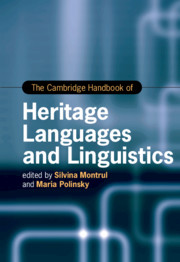Book contents
- The Cambridge Handbook of Heritage Languages and Linguistics
- Cambridge Handbooks In Language And Linguistics
- The Cambridge Handbook of Heritage Languages and Linguistics
- Copyright page
- Dedication
- Contents
- Figures and Tables
- Contributors
- Acknowledgments
- Introduction
- Part I Heritage Languages around the World
- 1 Slavic Heritage Languages around the Globe
- 2 Heritage Languages in Europe
- 3 Heritage Languages in Southeastern Europe
- 4 Heritage Languages in China
- 5 Heritage Languages in Japan and Korea
- 6 Heritage Languages in Israel
- 7 Heritage Languages in Aotearoa New Zealand and Australia
- 8 Heritage Languages in Canada
- 9 Asian Heritage Languages in the United States
- 10 The Vitality of Spanish as a Heritage Language in the United States
- 11 Germanic Heritage Varieties in the Americas
- 12 Arabic in North America
- 13 Heritage Languages in South America
- 14 Language Attrition and Heritage Language Reversal in Returnees
- Part II Research Approaches to Heritage Languages
- Part III Grammatical Aspects of Heritage Languages
- Part IV Heritage Language Education
- Index
- References
14 - Language Attrition and Heritage Language Reversal in Returnees
from Part I - Heritage Languages around the World
Published online by Cambridge University Press: 04 November 2021
- The Cambridge Handbook of Heritage Languages and Linguistics
- Cambridge Handbooks In Language And Linguistics
- The Cambridge Handbook of Heritage Languages and Linguistics
- Copyright page
- Dedication
- Contents
- Figures and Tables
- Contributors
- Acknowledgments
- Introduction
- Part I Heritage Languages around the World
- 1 Slavic Heritage Languages around the Globe
- 2 Heritage Languages in Europe
- 3 Heritage Languages in Southeastern Europe
- 4 Heritage Languages in China
- 5 Heritage Languages in Japan and Korea
- 6 Heritage Languages in Israel
- 7 Heritage Languages in Aotearoa New Zealand and Australia
- 8 Heritage Languages in Canada
- 9 Asian Heritage Languages in the United States
- 10 The Vitality of Spanish as a Heritage Language in the United States
- 11 Germanic Heritage Varieties in the Americas
- 12 Arabic in North America
- 13 Heritage Languages in South America
- 14 Language Attrition and Heritage Language Reversal in Returnees
- Part II Research Approaches to Heritage Languages
- Part III Grammatical Aspects of Heritage Languages
- Part IV Heritage Language Education
- Index
- References
Summary
The present chapter provides an overview of the main questions investigated in research on bilingual returnees. Returnees are second/third generation speakers who grow up in a migration setting and move back to their families’ country of origin at a certain moment of their life. On the one hand, research on returnees focuses on dominant language attrition, i.e., on the linguistic changes that affect the previous societal language after moving to the homeland. On the other hand, it targets L1/HL development after immersion in the L1/HL environment and possible outcomes of heritage language reversal. In addition to the focus on language development, we discuss the pedagogical and sociological implications of return to the country of origin, which go hand in hand with changes to the returnee’s language competence.
Keywords
- Type
- Chapter
- Information
- The Cambridge Handbook of Heritage Languages and Linguistics , pp. 351 - 372Publisher: Cambridge University PressPrint publication year: 2021
References
- 9
- Cited by



